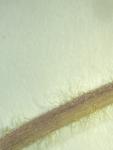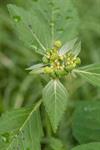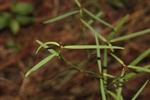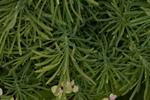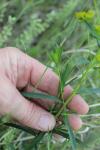Click the number at the start of a key lead to highlight both that lead and its corresponding lead. Click again to show only the two highlighted leads. Click a third time to return to the full key with the selected leads still highlighted.
1 Shrubs with succulent stems; [subgenus Euphorbia, sect. Crepidaria]. |
|
|
|
....3 Leaves strictly opposite, oblique or inequilateral at base; branches prostrate (less usually erect); [subgenus Chamaesyce; section Anisophyllum] |
....3 Leaves alternate or opposite, not oblique or asymmetric at base; branches usually erect. |
......4 Bracteal leaves lobed or toothed (rarely linear), usually marked with red or white at the base or purple-spotted; glands of the cyathia usually 1 (rarely more), bilabiate, lacking petaloid appendages; [subgenus Chamaesyce; section Poinsettia] |
......4 Bracteal leaves entire, not marked with red (white-margined in E. marginata); glands of the cyathia 4-5, flattish, not bilabiate, with or without petaloid appendages. |
........5 Glands of the cyathia 5 (or 7-10 on the central cyathium in E. pubentissima), with petaloid appendages 0.1-5.0 mm long (measured along a radius), these white, maroon, red, pink, or green; stipules present, glandlike, often minute; [subgenus Chamaesyce; section Alectoroctonum] |
........5 Glands of the cyathia 4 (except 5 in E. purpurea), oval, reniform, or crescent-shaped, lacking petaloid appendages (the glands themselves yellowish or green); stipules absent or vestigial |
..........6 Ovary and capsule subtended by a calyx-like structure; seeds without caruncles; involucral gland appendages absent; [subgenus Euphorbia; section Nummulariopsis] |
..........6 Ovary and capsule not subtended by a calyx-like structure; seeds with caruncles; involucral gland appendages hornlike or absent; [subgenus Esula] |
1 Young stems and leaves glabrous; leaves either entire or serrulate, at least at the apex (use 10× magnification). |
..2 Leaves serrulate, at least at the apex (use 10× magnification); seeds with 2-4 transverse ridges. |
....3 Seeds 1.0-1.3 mm long, with 3-4 (-6) transverse ridges; involucre 0.6-0.9 mm long; stems prostrate; [s. IN and c. TN westward, primarily w. of MS river] |
....3 Seeds 0.8-1.1 mm long, with 2-4 transverse ridges; involucre 0.9-1.1 mm long; stems erect to ascendant; [SC s. to FL and w. to TX in our region]. |
......4 Stipules conspicuous, 1.0-1.5 mm long; stems glabrous throughout; plants to 50 cm long; capsules 1.1-1.5 mm wide; seeds 0.9-1.1 mm long, with low, smooth ridges and shallow depressions between |
......4 Stipules inconspicuous, ca. 0.5 mm long; stems (at least sparsely) pilose proximally and glabrous distally; plants to 80 cm long; capsules 1.7-1.8 mm wide; seeds 1.0-1.4 mm long, with 2-3 prominent transverse ridges |
..2 Leaves absolutely entire; seeds smooth. |
........5 Stipules united into a triangular scale-like structure (this often lobed or fringed), thus appearing as 2 stipules at each node |
........5 Stipules separate, lacerate, appearing as 3 or 4 stipules at each node. |
..........6 Mature seeds bluntly angled or subangled in cross section, 1.0-1.4 (1.6) mm long (except for 1.8-2.1 mm long in E. cordifolia); leaves either 1.5-2× or 4-5× as long as wide, not fleshy; [sandy inland habitats or coastal dunes in E. cumulicola]. |
............ 7 Leaves 1.5-2× as long as wide, green throughout; [more widespread]. |
............ 7 Leaves 4-5× as long as wide, the leaf margin red; [FL] |
............ ..8 Seeds ashy white with a brown longitudinal line on adaxial surface, 1.1-1.4 (-1.6) mm long; leaf bases angled or rounded, with one side of the leaf base often expanded into a small rounded auricle |
............ ..8 Seeds gray or tan with dark brown mottling, 1.8-2.1 mm long; leaf bases cordate to rounded, without an auricle on one side |
..........6 Mature seeds rounded in cross section, (1.3-) 1.5-2.6 mm long; leaves 2-3 (-5)× as long as wide, often somewhat fleshy; [of barrier island dunes and other sandy coastal habitats]. |
............ ....9 Mature seeds (1.3-) 1.5-1.9 mm long; cyathia terminal on the stems and also axillary |
............ ....9 Mature seeds (2.0-) 2.2-2.6 mm long; cyathia terminal on the stems |
1 Young stems and leaves pubescent (at least in lines along the stems); leaves serrulate, at least at the apex (use 10× magnification). |
............ ......10 Ovary and capsule glabrous. |
............ ........11 Seeds 0.8-1.0 mm long, light gray, the faces with 2-3 (-4) horizontal, low, blunt ridges, sometimes connected by 1-2 cross ridges; stems glabrous when young (uncommonly puberulent along 1 side of the branchlets); capsule 1.5-2.0 mm long |
............ ........11 Seeds 1.0-1.3 mm long, dark gray, faces without ridges, though irregularly and finely wrinkled; stems puberulent when young on 1 side only; capsule 2.0-2.5 mm long. |
............ ..........12 Stems ascending or suberect, puberulent when young |
............ ..........12 Stems prostrate or widely spreading, spreading-hirsute |
............ ......10 Ovary and capsule pubescent. |
............ ............ 13 Stems with 2 types of trichomes, the longer 3-5 mm long; cyathia in axillary and terminal cymes, at least some of the peduncles > 10 mm long |
............ ............ 13 Stems with 1 type of trichome, these < 2 mm long; cyathia solitary or several in axils, the peduncles < 5 mm long. |
............ ............ ..14 Capsules spreading-villous, especially or solely on the angles; styles 0.2-0.3 mm long, bifid nearly to the base; seeds sharply quadrangular-angled, the faces with 3-4 transverse ridges |
............ ............ ..14 Capsules minutely appressed-puberulent, on the entire surface (though sometimes primarily on the lower portion); styles 0.3-0.7 mm long, bifid only in the upper half or third; seeds quadrangular but not angled, the faces with inconspicuous transverse ridges or nearly smooth. |
............ ............ ....15 Involucre cleft on 1 side half its length; leaves mostly obovate, 1.5-2× as long as wide; styles 0.5-0.7 mm long, filiform; seed faces nearly smooth; adventitious roots formed at middle nodes along the stem |
............ ............ ....15 Involucre cleft on 1 side a fourth to a third its length; leaves mostly oblong, 2-3× as long as wide; styles 0.3-0.4 mm long, clavate; seed faces transversely ridged; adventitious roots not formed |
1 Principal stem leaves opposite, dentate, neither lobed nor linear; plant pubescent. |
..2 Leaf undersurface hairs stiff and distinctly widened towards their bases; capsules 4.0-4.8 mm wide; seeds angular in cross section, unevenly tuberculate |
..2 Leaf undersurface hairs soft and little or not thickened towards their bases; capsules 3.5-4.0 mm wide; seeds rounded in cross section, evenly tuberculate |
1 Principal stem leaves alternate, either lobed or linear; plant usually glabrous. |
....3 Cyathial gland with a circular opening; bracteal leaves wholly green or green and paler at base (sometimes purple-spotted); seeds angular, with a small caruncle and pronounced longitudinal dorsal ridge, but lacking a distinct transverse tubercular ridge near the middle |
....3 Cyathial gland 2-lipped, the opening elliptical and elongate; bracteal leaves wholly green, purple, white, pink, or red, or green or purplish towards the tip and white, pink, or red at the base; seeds cylindrical, lacking both a caruncle and longitudinal dorsal ridge, but with a distinct transverse tubercular ridge near the middle. |
......4 Annual herbs from spreading taproots; leaf blades 4-40 mm wide; bracteal leaves usually green with white, pink, or red at base, or some or all bracts wholly white, pink, red, or green; capsules green at maturity; involucral glands 1; [widespread in our region] |
......4 Perennial herbs with thick, woody taproots; bracteal leaves usually purplish green (or with pink at base); capsules purplish at maturity; involucral glands 3-5; [s. FL] |
1 Upper stem leaves and/or dichasial bracts with white margins or entirely white. |
..2 Cyathial bracts glabrous, often entirely white (less commonly only white along margins) |
..2 Cyathial bracts densely pilose, with conspicuous white margins. |
....3 Leaf surfaces pilose; cyathial bracts linear to narrowly oblanceolate; seeds 4.3-4.5 mm long |
....3 Leaf surfaces glabrous; cyathial bracts narrowly elliptic to oblanceolate; seeds 3.7-3.9 mm long |
1 Upper stem leaves and bracteal leaves entirely green, not whitened. |
......4 Leaves opposite, linear-filiform; [primarily of the c. US, w. of the MS river] |
......4 Leaves alternate, variously shaped (linear to ovate); [widespread, including c. US]. |
........5 Petaloid appendages (0.5-) 1.0-4.4 mm long (measured along a radius), about as long as wide or longer, white; stems 1.4-9 (-11) dm tall, erect or ascending. |
..........6 Leaves broad (ovate, oblanceolate, elliptic, or lanceolate), < 5.5× as long as wide; leaf blades slightly revolute or planar; glands green. |
............ 7 Involucral glands 4; leaf adaxial (upper) surface densely pilose; leaf bases cordate |
............ 7 Involucral glands 5; leaf adaxial (upper) surface usually glabrous (besides ciliate margins in E. apocynifolia); leaf bases cuneate to rounded. |
............ ..8 Petioles 5-11 mm long; leaves with ciliate margins; cyathia across the appendages ca. 2.5 mm; nodes 7-11 below the umbels; [shady, mesic hardwood forests over limestone or in sand over limestone] |
............ ..8 Petioles 0-3.5 (-10) mm long; leaves without ciliate margins; cyathia across the appendages (3.5-) 4-8 (-11) mm; nodes 20-75 nodes below the umbels; [habitats various, generally open, drier, and acidic, e.g., pine woods, sandhills, sandstone, ruderal sites] |
............ ....9 Plants (2-) 4-9 (-13) dm tall; aerial stems multiple, (1-) 3-10 stems from a crown, each (1.2-) 2.5-5 (-7) mm in diameter at the base; leaves ascending, leathery, sessile; primary bracts smaller than stem leaves; petaloid appendages oblong or spatulate, 2.5-4.4 mm long; seeds 2.6-3.2 mm long; [NH and MA west to s. ON, MI, WI, MN, and NE, south to se.VA, c. NC, n. GA, s. AL, and e. TX] |
............ ....9 Plants 3.5-6.5 dm tall; aerial stems 1 (-3) from a crown, each 1.0-2.2 mm in diameter at the base; leaves usually reflexed, thin, petiolate or subpetiolate; primary bracts similar to stem leaves in size; petaloid appendages orbicular or oval, 0.9-2.2 mm long; seeds 1.8-2.3 mm long; [c. MD, VA, and c. and sw. TN, south to Panhandle FL and s. MS] |
..........6 Leaves linear, > 8× as long as wide); leaf blades conspicuously revolute or involute; glands green or dark purple. |
............ ......10 Main stem not branching at base, erect or ascending, usually densely pubescent, dark grey or green; leaves not succulent, revolute, petiolate; stipules obsolete; glands green or rarely purple; petaloid appendages entire; [e. and c. GA (or e. SC?) south and west to Panhandle FL and e. TX] |
............ ......10 Main stem branching at base, ascending or spreading, glabrous, green or greenish purple; leaves succulent, involute, sessile or short petiole; stipules present and glandular; glands purple; petaloid appendages deeply crenate; [c. and s. peninsular FL] |
........5 Petaloid appendages 0.05-0.6 mm long (measured along a radius), shorter than wide, green, red, white, or pink; stems (0.8-) 1.5-4.5 (-6) dm tall, erect, ascending or decumbent; leaves ciliate-margined ( E. mercurialina and E. curtisii) or not. |
............ ........11 Leaf margins ciliate; cyathia 3.5-5.9 mm wide (across the appendages), green; leaves not fleshy, 1.7-2.2 (-3)× as long as wide, not especially variable; [of mesic forests with rich soils] |
............ ........11 Leaf margins not ciliate (except some marginal hairs in E. curtisii); cyathia 2.0-3.4 mm wide (across the appendages), green or maroon; leaves slightly to strongly fleshy, 0.7-20× as long as wide, often very variable in shape, even on the same plant; [of more or less xeric sandhill woodlands with acidic, sandy soils]. |
............ ..........12 Stems usually 10-18 per crown, decumbent to weakly ascending; leaves opposite (scales on the lower stem sometimes alternate), fleshy, blue-green with a narrow, thickened, red-hyaline margin; branching dichotomous from the base of the plant (the branches typically equal, though sometimes unequal) |
............ ..........12 Stems 1-4 (-9) per crown, erect to strongly ascending; leaves alternate, opposite, or in whorls of 3 (at least some alternate on a plant), less fleshy, green to blue-green, without a red margin (or with a very narrow, slightly red-hyaline, but not thickened margin in E. exserta); branching alternate below the inflorescence (rarely dichotomous or trichotomous), the branches typically unequal. |
............ ............ 13 Cyathia and capsules green; petaloid appendages white or pink; leaves thin-textured, green, finely pubescent with appressed white hairs (0.1-0.3 mm long) on the lower surface and margins (visible at 10× or greater); branching primarily alternate; leaves primarily alternate (typically opposite or 3-whorled below the inflorescence); cyathia unisexual, plants usually unisexual (dioecious) |
............ ............ 13 Cyathia and capsules maroon; petaloid appendages maroon-red; leaves slightly fleshy, somewhat blue-green, glabrous; branching primarily opposite; leaves primarily opposite (usually some alternate on upper branches); cyathia bisexual, plants bisexual |
1 Principal stem leaves finely serrulate (especially toward the apex); [subgenus Esula, section Helioscopia]. |
..2 Ovary and capsule smooth |
....3 Leaf margins crenulate, the teeth rounded; terminal pleiochasial branches (rays) usually 3 and not or less radiant from above; capsules 1.6-2 mm long; seeds 1.4-1.5 mm long; [endemic to southeastern TX and adjacent LA |
....3 Leaf margins serrulate, the teeth pointed; terminal pleiochasial branches (rays) usually 5 and conspicuously radiating from above; capsules 2.5-4 mm long; seeds 1.6-2.2 mm long [uncommon non-native of disturbed areas in e. US] |
..2 Ovary and capsule verrucose-roughened. |
......4 Plants perennial, with thickened woody taproots; stems villous (often densely so, especially on inflorescence branches); leaves to 25 mm wide; [non-native waif] |
......4 Plants annual, rarely biennial, with thin herbaceous to only partially woody taproots; stems glabrous (or occasionally pilose in E. platyphyllos); leaves to 11 mm wide; [natives and waifs]. |
........5 Leaves sparsely pilose, usually with acute apices; plants usually with 5 terminal pleiochasial branches; [non-native waif, disturbed areas] |
........5 Leaves glabrous, usually with obtuse or rounded apices; plants usually with 3 terminal pleiochasial branches; [natives of intact and disturbed areas]. |
..........6 Seeds smooth or very obscurely reticulate, 1.7-2.5 mm long; cyathia with the involucre 1.2-1.5 mm long; involucral bracts typically red; dichasial bracts cordate-clasping |
..........6 Seeds distinctly alveolate, 1.3-1.8 mm long; cyathia with the involucre 0.6-0.9 mm long; involucral bracts typically yellow; dichasial bracts rounded to subcordate |
1 Principal stem leaves entire. |
............ 7 Stem leaves opposite, decussate (each succeeding pair turned by 90 degrees); seeds 4-6 mm long; [subgenus Esula, section Lathyris] |
............ 7 Stem leaves alternate (or mostly so); seeds 1-3 mm long. |
............ ..8 Stem leaves linear to narrowly oblong, 10-90 mm long (5-30 mm long in E. cyparissias), averaging ca. 10× as long as wide; [subgenus Esula, section Esula]. |
............ ....9 Stem leaves 10-30 mm long, (5-)10-30 mm wide |
............ ....9 Stem leaves 30-80 mm long, 3-8(-12) mm wide |
............ ..8 Stem leaves oblanceolate, obovate, elliptic, spatulate, or oblong, 10-100 (-150) mm long, (3-)5-30 mm wide, averaging 1-5× as long as wide. |
............ ......10 Principal stem leaves elliptic to oblong, (50-) 70-100 cm long; rhizomatous perennial to 1 m tall; seeds smooth, 3-5 mm long; rays of the umbel usually 5-8; [subgenus Esula, section Helioscopia] |
............ ......10 Principal stem leaves oblanceolate to obovate, 10-20 mm long; annual, biennial, or perennial by basal offshoots, to 0.4 m tall; seeds pitted, 1.3-2.0 mm long; rays of the umbel 3 (-5). |
............ ........11 Seeds pitted only on one face, the inner face furrowed; [subgenus Esula, section Tithymalus] |
............ ........11 Seeds pitted on both the inner and outer faces. |
............ ..........12 Seeds coarsely pitted with transversely elongate pits in 4 vertical rows (appearing nearly transversely rugose); glands of the cyathia crescent-shaped, the horns short and blunt; [subgenus Esula, section Pithyusa] |
............ ..........12 Seeds either finely pitted with numerous, evenly distributed, isodiametric pits, or tuberculate; glands of the cyathia crescent-shaped, the horns slender, elongate, and caudate; [subgenus Esula, section Tithymalus]. |
............ ............ 13 Seeds tuberculate |
............ ............ 13 Seeds finely pitted with numerous, evenly distributed, isodiametric pits. |
............ ............ ..14 Dichasial bracts connate 1/4-1/2 of their length (often only on one side) |
............ ............ ....15 Petioles 0-3 mm long; capsules ovoid-globose, 2.6-2.7 mm long; seeds with deep, rounded pits in 3-4 regular, vertical rows; [Interior Highlands of AR, e. OK, and s. MO; disjunct in c. TN] |
............ ............ ....15 Petioles 2-5 mm long; capsules subglobose, 2-2.5 mm long; seeds with scattered, deep and broad pits; [TX] |
............ ............ ..14 Dichasial bracts usually distinct, occasionally subconnate basally. |
............ ............ ......16 Dichasial bracts strongly imbricate; seeds gray to purple-gray or sometimes nearly black |
............ ............ ......16 Dichasial bracts not imbricate; seeds white to gray or red-brown to brown. |
............ ............ ........17 Biennial or occasionally annual herbs; petioles of lower stem leaves 5-10 mm long; leaf blades usually oblanceolate to obovate, rarely ovate, 3-10 mm wide (at least some blades more than 5 mm wide); capsules 2.5-3.2 mm long. |
............ ............ ........17 Annual herbs; petioles of lower stem leaves 0-2 mm long; leaf blades linear to oblanceolate, spatulate-cuneate, or slightly lanceolate, 0.5-5 mm wide; capsules 1.8-2.4 mm long. |
............ ............ ..........18 Seeds reddish brown to brown, 1.3-1.4 × 0.8-0.9 mm, with 4-6 shallow pits or irregular oblong grooves on adaxial faces, small-pitted or nearly smooth on abaxial faces. |
............ ............ ..........18 Seeds white to gray, 1.4-1.7 × 1-1.6 mm, with pits scattered over entire surface. |
............ ............ ............ 19 Leaf blades oblanceolate, 3-5 mm wide; seeds ovoid, 1.6-1.7 × 1.4-1.6 mm; [granitic outcrops, GA]. |
............ ............ ............ 19 Leaf blades linear to slightly lanceolate or linear-oblanceolate, 0.5-2.5 mm wide; seeds ellipsoid, 1.4-1.7 × 1.0-1.3 mm; [sandy soils, TX Coastal Plain]. |
............ ............ ............ ..20 Stems 10-22 cm tall; leaf blades linear-oblanceolate, apices rounded; dichasial bracts reniform-ovate to subdeltate-ovate, bases truncate; seeds 1.6-1.7 × 1.1-1.3 mm, the surfaces with regular concave depressions; [Atascosa, Bexar, Wilson counties, TX]. |
............ ............ ............ ..20 Stems 6-13 cm tall; leaf blades linear to slightly lanceolate, apices acute; dichasial bracts broadly ovate-lanceolate, bases rounded; seeds 1.4-1.5 × 1-1.1 mm, the surfaces with irregular, not obviously concave depressions; [Jim Hogg, Kenedy counties, TX] |



